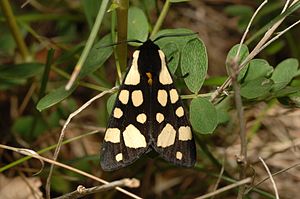Black bear (butterfly)
| Black bear | ||||||||||||
|---|---|---|---|---|---|---|---|---|---|---|---|---|

Black Bear ( Arctia villica ) |
||||||||||||
| Systematics | ||||||||||||
|
||||||||||||
| Scientific name | ||||||||||||
| Arctia villica | ||||||||||||
| ( Linnaeus , 1758) |
The black bear ( Arctia villica ) is a butterfly ( moth ) from the subfamily of the bear moth (Arctiinae).
features
The moths reach a wingspan of 45 to 60 millimeters. They have black fore wings with white, extensive spots that can run into each other. There are also spots that are very small. The orange hind wings have black spots. The caterpillars are black with medium-length, not very densely growing tufts of light brown hair. Her head and legs are red.
Similar species
- Brown bear ( arctia caja )
- English bear ( Arctia festiva )
Occurrence
The species is distributed from North Africa and the Iberian Peninsula across Western and Southern Europe and the Black Sea region to Russia and the Middle East. In southern and central Europe , the moths can be found in sunny and warm areas with bushes and hedges . In Germany, the species can only be found very locally in places with less heat ( Hesse , Rhineland-Palatinate , Bavaria (Danube slopes near Passau) Saarland , Brandenburg ). Proven in Austria in all heat-favored areas from Tyrol to Burgenland . In Upper Austria the species only occurs like islands, especially north of the Danube.
Flight and caterpillar times
The black bear moths can be seen from June to July. Ebert reports the following about the behavior of the caterpillars under breeding conditions: By the end of June / beginning of July the caterpillars ate various herbs and grew to a length of approx. 10-12 mm, then they took a summer diapause (absolutely dry housing, no food intake, often over 30 ° C daytime temperature). From September (to October) new food intake and with a size of approx. 20 mm winter diapause. From February / March then further breeding until pupation.
Way of life
The caterpillars overwinter, but they are relatively sensitive to frost. They only pupate in May on the ground in a white-gray web. The caterpillars eat a variety of lower herbs:
- Common dandelion ( Taraxacum sect.Ruderalia )
- Plantain ( Plantago )
- Dead nettles ( Lamium )
- Yarrow ( Achillea )
- Blackberries ( rubus )
- Strawberries ( Fragaria )
The moths are nocturnal, but the females also fly during the day. They can be found resting on leaves, where they fly up in the event of disturbances but already collapse into the vegetation after a short flight. You are attracted to the light.
Hazard and protection
The black bear is listed in Germany's Red List of Endangered Animals: 1 (critically endangered).
swell
Individual evidence
- ↑ Gerfried Deschka, Josef Wimmer: Ecological valence analysis with large butterflies as indicators in the community of Waldhausen in Upper Austria. In: Yearbook of the Upper Austrian Museum Association. Society for Regional Studies, Linz 1996 ( PDF on ZOBODAT ).
- ↑ a b Günter Ebert (Ed.): The Butterflies of Baden-Württemberg Volume 5, Moths III (Sesiidae, Arctiidae, Noctuidae). Ulmer Verlag, Stuttgart 1997, ISBN 3-8001-3481-0
- ↑ Federal Agency for Nature Conservation (Ed.): Red List of Endangered Animals in Germany. Landwirtschaftsverlag, Münster 1998, ISBN 3-89624-110-9
literature
- Hans-Josef Weidemann, Jochen Köhler: Moths. Weirdos and hawkers. Naturbuch-Verlag, Augsburg 1996, ISBN 3-89440-128-1 .
- Manfred Koch , Wolfgang Heinicke: We identify butterflies. 3. Edition. Neumann, Radebeul 1991, ISBN 3-7402-0092-8 .
- Michael Chinery: Parey's Book of Insects. A field guide of European insects. Publishing house Franckh-Kosmos, Stuttgart 2004, ISBN 3-440-09969-5


